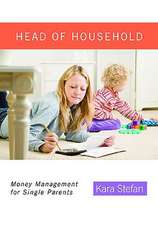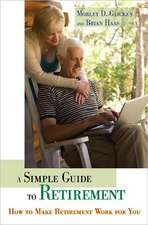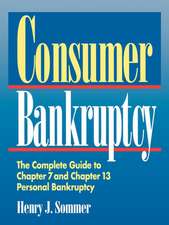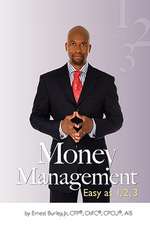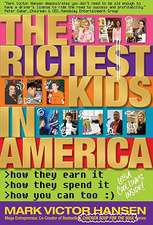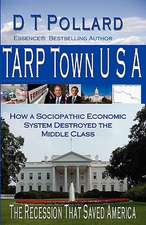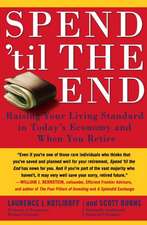How to Get Out of Debt, Stay Out of Debt, and Live Prosperously*: Based on the Proven Principles and Techniques of Debtors Anonymous
Autor Jerrold J. Mundisen Limba Engleză Paperback – 31 dec 2002
“A must read for anyone wanting to get their head above water.”—The Wall Street Journal
THE CLASSIC GUIDE, REVISED WITH UP-TO-THE-MINUTE INFORMATION
OUT OF THE RED
• Do this month’s bills pile up before you’ve paid last month’s?
• Do you regularly receive past-due notices?
• Do you get letters threatening legal action if immediate payment is not made?
• Do the total amounts of your revolving charge accounts keep rising?
INTO THE BLACK
Whether you are currently in debt or fear you’re falling into debt, you are not alone. Sixty million Americans—from doctors to secretaries, from executives to the unemployed—face the same problem and live under the same daily stress. Based on the proven techniques of the national Debtors Anonymous program, here is the first complete, step-by-step guide to getting out of debt once and for all. You’ll learn
• how to recognize the warning signs of serious debt
• how to negotiate with angry creditors, collection agencies, and the IRS
• how to design a realistic and painless payback schedule
• how to identify your spending blind spots
• how to cope with the anxiety and daily pressures of owing money
• plus the three cardinal rules for staying out of debt forever, and much more!
This book is neither sponsored nor endorsed by Debtors Anonymous. A recovered debtor, the author is intimately familiar with the success of the Debtors Anonymous program.
Preț: 102.40 lei
Nou
Puncte Express: 154
Preț estimativ în valută:
19.59€ • 20.51$ • 16.21£
19.59€ • 20.51$ • 16.21£
Carte disponibilă
Livrare economică 17-31 martie
Preluare comenzi: 021 569.72.76
Specificații
ISBN-13: 9780553382020
ISBN-10: 0553382020
Pagini: 336
Dimensiuni: 153 x 204 x 18 mm
Greutate: 0.25 kg
Ediția:Bantam Rev Trad.
Editura: Bantam
ISBN-10: 0553382020
Pagini: 336
Dimensiuni: 153 x 204 x 18 mm
Greutate: 0.25 kg
Ediția:Bantam Rev Trad.
Editura: Bantam
Notă biografică
Jerrold Mundis is a writer, speaker, and counselor. His books have been selected by the Book-of-the-Month Club, Literary Guild, One Spirit Book Club, and others, and translated into a dozen foreign languages. His short work has appeared in such publications as the New York Times Magazine and American Heritage. A recovered debtor himself, he is intimately familiar with the success of the Debtors Anonymous program. Mundis speaks regularly on debt and personal money for clients ranging from the U.S. Customs Service to the National Education Association, Unity Church, and professional societies and associations. He also works privately with individuals across the United States and in other countries as well, by telephone. Jerrold Mundis lives in New York City.
Extras
What Is Debt?
I.O.U.
In its simplest definition, you are in debt when you owe some person or institution money. We need a refinement though. For our purposes, a secured loan is not a debt, even though money has been loaned to you.
The Secured Loan
To secure something is to make it safe. When you secure a loan, you free the lender from any risk of losing his money. That's why he's willing to lend it to you, he has no fear of loss.
Your word, your good faith, even your unfailing history of repayment do not secure a loan. What happens if you have medical emergencies, lose your job, or simply go bonkers and run off to Brazil? If, for any reason, you just don't have the money to pay the loan back? The lender loses his money, that's what.
Collateral, in its primary definition, is something that runs side by side with something else. In financial terms, collateral is property you pledge to the lender or actually give to him to hold during the course of the loan. That property is security, it's what makes the lender's money safe or secured. When you pay him back, he returns it to you.
A loan from a pawnshop is a classic example. You bring your camera to the pawnbroker. He loans you $75. When you repay him the $75 (plus interest, of course), he gives your camera back to you. If you don't repay him, he keeps your camera. You don't own your camera anymore, but you don't owe him $75 either. The loan is over.
Fine, you say, but you're not interested in hockshops and cameras. You're talking big money, $5,000, $50,000, more.
The Numbers Don't Make Any Difference.
A loan is a loan, whether it's for $5, $500, or $50,000. And collateral is collateral, whether it's a television set or a television station.
One of the most common forms of secured loan is a mortgage. Let's say I'm buying a house for $150,000. I've saved $30,000, which I use for the down payment. The bank likes my job history, my salary, and my credit record. They have confidence in me. But that confidence alone isn't enough to persuade them to lend me the additional $120,000 I need, not without strings attached. Life's too unpredictable for that. So they require me to give them a mortgage on my house, a document that generally grants them all legal rights to it if I default, that is, if I fail to make my loan payments for a specified period of time, usually about four months. The bank then has the right to foreclose the mortgage, to take possession of my house in lieu of what I owe them, sell it, and keep the proceeds or the bulk of the proceeds for themselves, thus recouping their $120,000. I've secured the loan by pledging my house as collateral. I've eliminated the risk that the bank will lose their money if they lend it to me.
Car loans work the same way. I buy a new Chevy for $24,000. I put $5,000 of my own money down and borrow the balance, $19,000, from a bank or from General Motors. To get the financing, I sign a document that gives the lender all rights and title to the car if I don't pay the loan back.
If I default in either of these cases, I lose my house or my car. That would be painful, but I would not owe money to anyone. I would not go into debt, provided I had made a large enough down payment. That is an important provision. Normally what happens in the case of a house or a car walked away from, foreclosed upon, repossessed or otherwise reclaimed by the lender, is that the lender sells off the property, deducts the amount received from the outstanding balance, and arrives at a new balance owed: the old one minus the proceeds of the sale.
Let's say that Frank, who still owes $9,000 on his Honda, is moving to another state and a new job where, among other benefits, he will have the use of a car. He's broke and under time pressure. So he turns the car over to the creditor (almost always a bank), and says, "Here, it's all yours. The loan is over." But it's not. The bank now has Frank's car, the collateral for the loan, but the loan is still in effect. The bank, which is a business, not a social welfare agency, wants to clear this loan quickly and with minimal effort. So it wholesales the Honda out, getting $5,000 for it. Frank still owes the creditor $4,000 on the loan and has all the legal obligations and liabilities that any debtor does. He is still as vulnerable to the creditor if he defaults as he is to any other creditor.
The same scenario is true with a house. But there the bank will usually have required a large enough down payment so that the house can be turned over for the amount still owed, unless there has been a major decline in the real estate market.
The key, then, in these situations, is to put enough money down on a car or house so that you have sufficient equity in it, should you need to liquidate it, that you can do so for at least the amount you still owe on it. Selling a car or house yourself and paying off the creditor is always better than turning it back to the creditor, even if the creditor could liquidate it for the balance you still owe. This is for reasons relating to your credit history, which we'll discuss in a later chapter.
A cash loan can also be secured. Of course the collateral has to be worth at least as much, and usually more, than the amount borrowed. No bank will accept $1,000 worth of stock certificates as collateral against a $5,000 loan, just as no pawnbroker will lend me $50 if I give him my Bic lighter to hold.
These are examples of collateral often used to secure cash loans:
*Bearer bonds
*Stock certificates
*Home equity, in the form of a second mortgage
*Parcels of land or other real estate
*Inventory n Works of art
*Whole life insurance policies
*Precious metals n An owned franchise
*Copyrights
*Patents
*A business
As anyone who's in debt knows very well, banks and financial institutions aren't the only places we can get a loan. We borrow from employers in the form of salary advances, from the government, from colleges and universities for educational loans, from business associates, from acquaintances and coworkers, from friends and relatives.
The most frequent loan in America is probably the one taken from a friend:
"Can you let me have $5 till tomorrow?"
"I need $20 till payday."
"Can you spare $300 till my commission check comes in?"
"My broker's check won't reach me for another week. Can you spot me $1,500 till then?"
The loan from family members is also common. Young couples setting up household or buying their first house frequently borrow from their families. I bought my own first house in 1971. Everything I'd saved went for the down payment and closing costs. There were several other expenses involved in moving my family from a city apartment to a house in the mountains, so I borrowed $7,500 from my father.
Houses, of course, aren't the only things for which we tap relatives. We borrow from them when we're between jobs, for education, vacations, Christmas buying, for furniture, medical expenses, big tax bills, births, marriages, divorces, to get over a hump, or when things are difficult in general.
These loans are usually given on good faith alone; but occasionally they're secured too. There's even more latitude in finding collateral for a personal loan than there is for a commercial loan. Commercial lenders want collateral for which there's a ready market and a constant demand, which assures them they can convert it to cash immediately if the borrower defaults. While friends or relatives might eventually prefer to do the same thing, they're usually satisfied with collateral in the form of something they'd like to own or use themselves, such as a video camera.
As collateral on a $2,500 loan, I once offered a friend an antique ivory statue he'd always admired. He didn't want collateral from me at all, but for my own reasons (which aren't relevant here, but will be later) I was determined that this loan be genuinely secured. He accepted my resolve, but still refused to remove the statue from my house. What we finally agreed on was this: I assigned to him through my literary agent, to become effective at his request, all income from one of my books up to the amount of $2,500. He's a novelist himself, and that assignment was satisfactory and pleasing to us both.
The possibilities for collateral on personal loans are nearly limitless. For example, you can use:
*Anything that could secure a commercial loan
*A VCR
*A piece of jewelry
*A fur coat
*A work of art
*A musical instrument
*An antique
*A computer
*A coin collection
*A set of encyclopedias
*A sewing machine
*Luggage
*Furniture
*A camera
*A snowmobile
*A power tool
*A rug
To sum it up, a secured loan is this: Someone lends you money, you give him an article of equivalent or greater value to hold until you pay him back.
Why Secured Loans Are Not Debt
From a strict point of view, a secured loan is debt: It's money you "owe." But there is a difference, and that difference is crucial.
If things go wrong, for any reason at all, and you can't repay the loan, what happens? You forfeit your property. That may be painful, but you are not obligated to pay money to anyone.
You walk away clean. You don't owe anyone money. You're not in debt.
This Is It
Debt is:
1.Any amount of cash you borrow without putting up collateral
2.Any credit extended to you
3.Any service you take without paying for at the moment you receive it
Some common examples of incurring debt are:
*You're short this week, so you tap a friend at the office for $20.
*You need $500 to tide you over for a month, so you borrow it from your bank on your signature alone.
*You need a new winter coat but you don't have the money, so you call your parents and borrow it from them.
*You're out with a friend, you want to pick something up from a store, but you don't have enough cash, so you borrow a few dollars from her.
*You need your tax refund now and can't wait for it to arrive, so you ask your brother for $300.
*You buy a compact disc player from Macy's and charge it to your account.
*You gas up your car on your Mobil card.
*You go out to dinner and hand the waiter your Visa card.
*You fly to Chicago to spend Thanksgiving with your relatives and put the tickets on your American Airlines card.
*You buy your spring wardrobe on your Bloomingdale's card.
*You charge a new lawn mower to your Sears account.
*You need your car fixed but you can't pay your mechanic till next month; that's fine with him, so he does the work.
*Your child's college tuition is due, so you request an advance on salary or commissions.
*You need two caps and a root canal, but you don't have the money, so you arrange with your dentist to pay him off over the next several months.
These are all debts. You owe money to these people. They have no collateral from you: Your dentist can't sell the plaster cast of your mouth, Sears can't convert your signature into cash.
Take a few minutes for a discovery process here. On a pad of paper, write down any of the above, or variations on them, that you've done yourself over the past twelve months.
Draw a line beneath the list.
Now make a second list. Include here all the other ways you've incurred debt in the same period that aren't mentioned in the first list.
Now get creative. Make a third list, placing on this one all the ways you've heard through which your friends incur debt, then add every other way you can imagine.
Take a good look at these lists. They're a lot longer than you would have thought, aren't they? And they all add up to the same thing, debt.
This Is It Too
But we're not done yet. There are other, more subtle ways to incur debt.
What happens when you get behind on your rent?
My rent is $1,300 per month. Let's say it's July now. And let's say that last month I finally went for the eye exam I'd been putting off. It had been three years and my ophthalmologist wanted to do a full scan, which was sensible. My eyes proved healthy, but I did need a new prescription. The exam was $300, a new pair of glasses $225. My television, possibly in a gesture of sympathy with my old glasses, decided to commit suicide at the same time. So I bought a new one for $400. And, since I don't usually keep such things in mind, I was unhappily surprised to find that the premium for my life insurance was due, for $400. That's $1,325 I hadn't planned on spending in June.
Money's tight. So I don't pay my rent in July, planning to catch up in August. What I've done is taken a service, the use of my apartment, without paying for it.
I owe money; I've incurred a debt.
Could I have paid my rent? Sure. I might have arranged with my ophthalmologist to pay him off over a couple of months, bought my glasses on an American Express card, and put the television on Visa.
Either way, I go into debt.
Falling behind on unsecured obligations, then, is the second category of debt. The most common areas in which we do this are:
*Rent
*Telephone service
*Utilities (gas, electricity, water)
*Federal, state, and local income taxes
*Property taxes
*Alimony and child support
*Tuition
*Credit card bills (penalties for late or missed payments)
*Charge account statements (penalties for late or missed payments)
*Fuel bills
Turn to a fresh page on your pad of paper. Jot down the number of times you've been late by a month or more in any of these areas. Then add any more in which you were late that aren't included here. Now add any area you can think of where falling behind might be possible.
Surprising just how many ways there are to go into debt, isn't it? There's a whole supermarket of opportunities out there.
Debt, then, comes in almost limitless variations, but it's not hard to recognize once we're clear on what it is, borrowing cash without collateral, buying goods or taking services without paying for them immediately, and falling behind in unsecured obligations.
That recognition is a good start.
I.O.U.
In its simplest definition, you are in debt when you owe some person or institution money. We need a refinement though. For our purposes, a secured loan is not a debt, even though money has been loaned to you.
The Secured Loan
To secure something is to make it safe. When you secure a loan, you free the lender from any risk of losing his money. That's why he's willing to lend it to you, he has no fear of loss.
Your word, your good faith, even your unfailing history of repayment do not secure a loan. What happens if you have medical emergencies, lose your job, or simply go bonkers and run off to Brazil? If, for any reason, you just don't have the money to pay the loan back? The lender loses his money, that's what.
Collateral, in its primary definition, is something that runs side by side with something else. In financial terms, collateral is property you pledge to the lender or actually give to him to hold during the course of the loan. That property is security, it's what makes the lender's money safe or secured. When you pay him back, he returns it to you.
A loan from a pawnshop is a classic example. You bring your camera to the pawnbroker. He loans you $75. When you repay him the $75 (plus interest, of course), he gives your camera back to you. If you don't repay him, he keeps your camera. You don't own your camera anymore, but you don't owe him $75 either. The loan is over.
Fine, you say, but you're not interested in hockshops and cameras. You're talking big money, $5,000, $50,000, more.
The Numbers Don't Make Any Difference.
A loan is a loan, whether it's for $5, $500, or $50,000. And collateral is collateral, whether it's a television set or a television station.
One of the most common forms of secured loan is a mortgage. Let's say I'm buying a house for $150,000. I've saved $30,000, which I use for the down payment. The bank likes my job history, my salary, and my credit record. They have confidence in me. But that confidence alone isn't enough to persuade them to lend me the additional $120,000 I need, not without strings attached. Life's too unpredictable for that. So they require me to give them a mortgage on my house, a document that generally grants them all legal rights to it if I default, that is, if I fail to make my loan payments for a specified period of time, usually about four months. The bank then has the right to foreclose the mortgage, to take possession of my house in lieu of what I owe them, sell it, and keep the proceeds or the bulk of the proceeds for themselves, thus recouping their $120,000. I've secured the loan by pledging my house as collateral. I've eliminated the risk that the bank will lose their money if they lend it to me.
Car loans work the same way. I buy a new Chevy for $24,000. I put $5,000 of my own money down and borrow the balance, $19,000, from a bank or from General Motors. To get the financing, I sign a document that gives the lender all rights and title to the car if I don't pay the loan back.
If I default in either of these cases, I lose my house or my car. That would be painful, but I would not owe money to anyone. I would not go into debt, provided I had made a large enough down payment. That is an important provision. Normally what happens in the case of a house or a car walked away from, foreclosed upon, repossessed or otherwise reclaimed by the lender, is that the lender sells off the property, deducts the amount received from the outstanding balance, and arrives at a new balance owed: the old one minus the proceeds of the sale.
Let's say that Frank, who still owes $9,000 on his Honda, is moving to another state and a new job where, among other benefits, he will have the use of a car. He's broke and under time pressure. So he turns the car over to the creditor (almost always a bank), and says, "Here, it's all yours. The loan is over." But it's not. The bank now has Frank's car, the collateral for the loan, but the loan is still in effect. The bank, which is a business, not a social welfare agency, wants to clear this loan quickly and with minimal effort. So it wholesales the Honda out, getting $5,000 for it. Frank still owes the creditor $4,000 on the loan and has all the legal obligations and liabilities that any debtor does. He is still as vulnerable to the creditor if he defaults as he is to any other creditor.
The same scenario is true with a house. But there the bank will usually have required a large enough down payment so that the house can be turned over for the amount still owed, unless there has been a major decline in the real estate market.
The key, then, in these situations, is to put enough money down on a car or house so that you have sufficient equity in it, should you need to liquidate it, that you can do so for at least the amount you still owe on it. Selling a car or house yourself and paying off the creditor is always better than turning it back to the creditor, even if the creditor could liquidate it for the balance you still owe. This is for reasons relating to your credit history, which we'll discuss in a later chapter.
A cash loan can also be secured. Of course the collateral has to be worth at least as much, and usually more, than the amount borrowed. No bank will accept $1,000 worth of stock certificates as collateral against a $5,000 loan, just as no pawnbroker will lend me $50 if I give him my Bic lighter to hold.
These are examples of collateral often used to secure cash loans:
*Bearer bonds
*Stock certificates
*Home equity, in the form of a second mortgage
*Parcels of land or other real estate
*Inventory n Works of art
*Whole life insurance policies
*Precious metals n An owned franchise
*Copyrights
*Patents
*A business
As anyone who's in debt knows very well, banks and financial institutions aren't the only places we can get a loan. We borrow from employers in the form of salary advances, from the government, from colleges and universities for educational loans, from business associates, from acquaintances and coworkers, from friends and relatives.
The most frequent loan in America is probably the one taken from a friend:
"Can you let me have $5 till tomorrow?"
"I need $20 till payday."
"Can you spare $300 till my commission check comes in?"
"My broker's check won't reach me for another week. Can you spot me $1,500 till then?"
The loan from family members is also common. Young couples setting up household or buying their first house frequently borrow from their families. I bought my own first house in 1971. Everything I'd saved went for the down payment and closing costs. There were several other expenses involved in moving my family from a city apartment to a house in the mountains, so I borrowed $7,500 from my father.
Houses, of course, aren't the only things for which we tap relatives. We borrow from them when we're between jobs, for education, vacations, Christmas buying, for furniture, medical expenses, big tax bills, births, marriages, divorces, to get over a hump, or when things are difficult in general.
These loans are usually given on good faith alone; but occasionally they're secured too. There's even more latitude in finding collateral for a personal loan than there is for a commercial loan. Commercial lenders want collateral for which there's a ready market and a constant demand, which assures them they can convert it to cash immediately if the borrower defaults. While friends or relatives might eventually prefer to do the same thing, they're usually satisfied with collateral in the form of something they'd like to own or use themselves, such as a video camera.
As collateral on a $2,500 loan, I once offered a friend an antique ivory statue he'd always admired. He didn't want collateral from me at all, but for my own reasons (which aren't relevant here, but will be later) I was determined that this loan be genuinely secured. He accepted my resolve, but still refused to remove the statue from my house. What we finally agreed on was this: I assigned to him through my literary agent, to become effective at his request, all income from one of my books up to the amount of $2,500. He's a novelist himself, and that assignment was satisfactory and pleasing to us both.
The possibilities for collateral on personal loans are nearly limitless. For example, you can use:
*Anything that could secure a commercial loan
*A VCR
*A piece of jewelry
*A fur coat
*A work of art
*A musical instrument
*An antique
*A computer
*A coin collection
*A set of encyclopedias
*A sewing machine
*Luggage
*Furniture
*A camera
*A snowmobile
*A power tool
*A rug
To sum it up, a secured loan is this: Someone lends you money, you give him an article of equivalent or greater value to hold until you pay him back.
Why Secured Loans Are Not Debt
From a strict point of view, a secured loan is debt: It's money you "owe." But there is a difference, and that difference is crucial.
If things go wrong, for any reason at all, and you can't repay the loan, what happens? You forfeit your property. That may be painful, but you are not obligated to pay money to anyone.
You walk away clean. You don't owe anyone money. You're not in debt.
This Is It
Debt is:
1.Any amount of cash you borrow without putting up collateral
2.Any credit extended to you
3.Any service you take without paying for at the moment you receive it
Some common examples of incurring debt are:
*You're short this week, so you tap a friend at the office for $20.
*You need $500 to tide you over for a month, so you borrow it from your bank on your signature alone.
*You need a new winter coat but you don't have the money, so you call your parents and borrow it from them.
*You're out with a friend, you want to pick something up from a store, but you don't have enough cash, so you borrow a few dollars from her.
*You need your tax refund now and can't wait for it to arrive, so you ask your brother for $300.
*You buy a compact disc player from Macy's and charge it to your account.
*You gas up your car on your Mobil card.
*You go out to dinner and hand the waiter your Visa card.
*You fly to Chicago to spend Thanksgiving with your relatives and put the tickets on your American Airlines card.
*You buy your spring wardrobe on your Bloomingdale's card.
*You charge a new lawn mower to your Sears account.
*You need your car fixed but you can't pay your mechanic till next month; that's fine with him, so he does the work.
*Your child's college tuition is due, so you request an advance on salary or commissions.
*You need two caps and a root canal, but you don't have the money, so you arrange with your dentist to pay him off over the next several months.
These are all debts. You owe money to these people. They have no collateral from you: Your dentist can't sell the plaster cast of your mouth, Sears can't convert your signature into cash.
Take a few minutes for a discovery process here. On a pad of paper, write down any of the above, or variations on them, that you've done yourself over the past twelve months.
Draw a line beneath the list.
Now make a second list. Include here all the other ways you've incurred debt in the same period that aren't mentioned in the first list.
Now get creative. Make a third list, placing on this one all the ways you've heard through which your friends incur debt, then add every other way you can imagine.
Take a good look at these lists. They're a lot longer than you would have thought, aren't they? And they all add up to the same thing, debt.
This Is It Too
But we're not done yet. There are other, more subtle ways to incur debt.
What happens when you get behind on your rent?
My rent is $1,300 per month. Let's say it's July now. And let's say that last month I finally went for the eye exam I'd been putting off. It had been three years and my ophthalmologist wanted to do a full scan, which was sensible. My eyes proved healthy, but I did need a new prescription. The exam was $300, a new pair of glasses $225. My television, possibly in a gesture of sympathy with my old glasses, decided to commit suicide at the same time. So I bought a new one for $400. And, since I don't usually keep such things in mind, I was unhappily surprised to find that the premium for my life insurance was due, for $400. That's $1,325 I hadn't planned on spending in June.
Money's tight. So I don't pay my rent in July, planning to catch up in August. What I've done is taken a service, the use of my apartment, without paying for it.
I owe money; I've incurred a debt.
Could I have paid my rent? Sure. I might have arranged with my ophthalmologist to pay him off over a couple of months, bought my glasses on an American Express card, and put the television on Visa.
Either way, I go into debt.
Falling behind on unsecured obligations, then, is the second category of debt. The most common areas in which we do this are:
*Rent
*Telephone service
*Utilities (gas, electricity, water)
*Federal, state, and local income taxes
*Property taxes
*Alimony and child support
*Tuition
*Credit card bills (penalties for late or missed payments)
*Charge account statements (penalties for late or missed payments)
*Fuel bills
Turn to a fresh page on your pad of paper. Jot down the number of times you've been late by a month or more in any of these areas. Then add any more in which you were late that aren't included here. Now add any area you can think of where falling behind might be possible.
Surprising just how many ways there are to go into debt, isn't it? There's a whole supermarket of opportunities out there.
Debt, then, comes in almost limitless variations, but it's not hard to recognize once we're clear on what it is, borrowing cash without collateral, buying goods or taking services without paying for them immediately, and falling behind in unsecured obligations.
That recognition is a good start.
Descriere
Based on the proven techniques of the national Debtors Anonymous program, thousands of people have used Mundis' book to get themselves out of debt--and stay that way. With updated information and an all-new Preface from the author, this book is indispensable to any American who finds him or herself slipping into debt.


